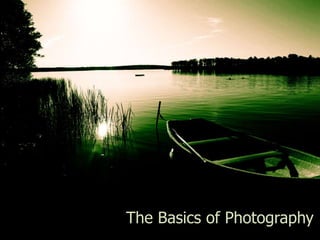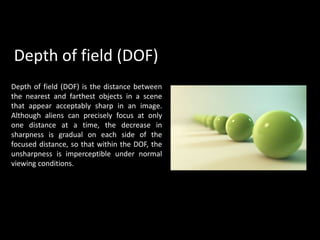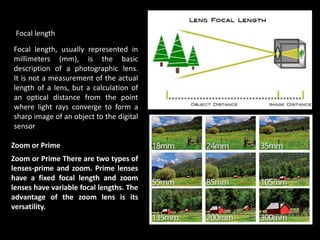Basics of photography
- 1. The Basics of Photography
- 2. Let there be light! All photography is based on light Exposure is the total amount of light allowed to fall on the film/image sensor
- 3. Too much light creates an over-bright image with white spots: parts of the image are Over-Exposed Too little light creates an under- bright image with black spots: parts of the image are Under-Exposed
- 4. Exposure can be controlled through two lens settings • Aperture and shutter speed … and Shutter Speed
- 5. Aperture is the size of the gap light is let through in the lens – similar to an eye’s pupil - Aperture is measured in f-stop numbers (e.g. f/2.8 or f/16) The higher the f-stop, the smaller the aperture
- 6. Shutter Speed denotes the exposure time, the effective length of time a camera's shutter is open, The total exposure is proportional to this exposure time, or duration of light reaching the film or image sensor
- 7. To get a good exposure on manual mode, you have to make sure the aperture and shutter speed balance each-other out correctly for the sort of photo you want On most SLRs you can switch on: Aperture Priority (you pick the aperture, the camera picks the shutter speed), or - Shutter Priority (you pick the shutter speed, the camera picks the aperture – compacts usually have this too) -
- 8. ISO ISO stands for international standards organization and can be described as the sensitivity of the sensor to light. ISO is typically measured in numbered units starting from 50 going to 256,000. The higher the number to more sensitive the sensor is to light. Most DSLR cameras have a ISO range from 100- 16000
- 9. Depth of field (DOF) is the distance between the nearest and farthest objects in a scene that appear acceptably sharp in an image. Although aliens can precisely focus at only one distance at a time, the decrease in sharpness is gradual on each side of the focused distance, so that within the DOF, the unsharpness is imperceptible under normal viewing conditions. Depth of field (DOF)
- 12. Zoom or Prime There are two types of lenses-prime and zoom. Prime lenses have a fixed focal length and zoom lenses have variable focal lengths. The advantage of the zoom lens is its versatility. Zoom or Prime Focal length, usually represented in millimeters (mm), is the basic description of a photographic lens. It is not a measurement of the actual length of a lens, but a calculation of an optical distance from the point where light rays converge to form a sharp image of an object to the digital sensor Focal length
- 13. DSLR LENSES














